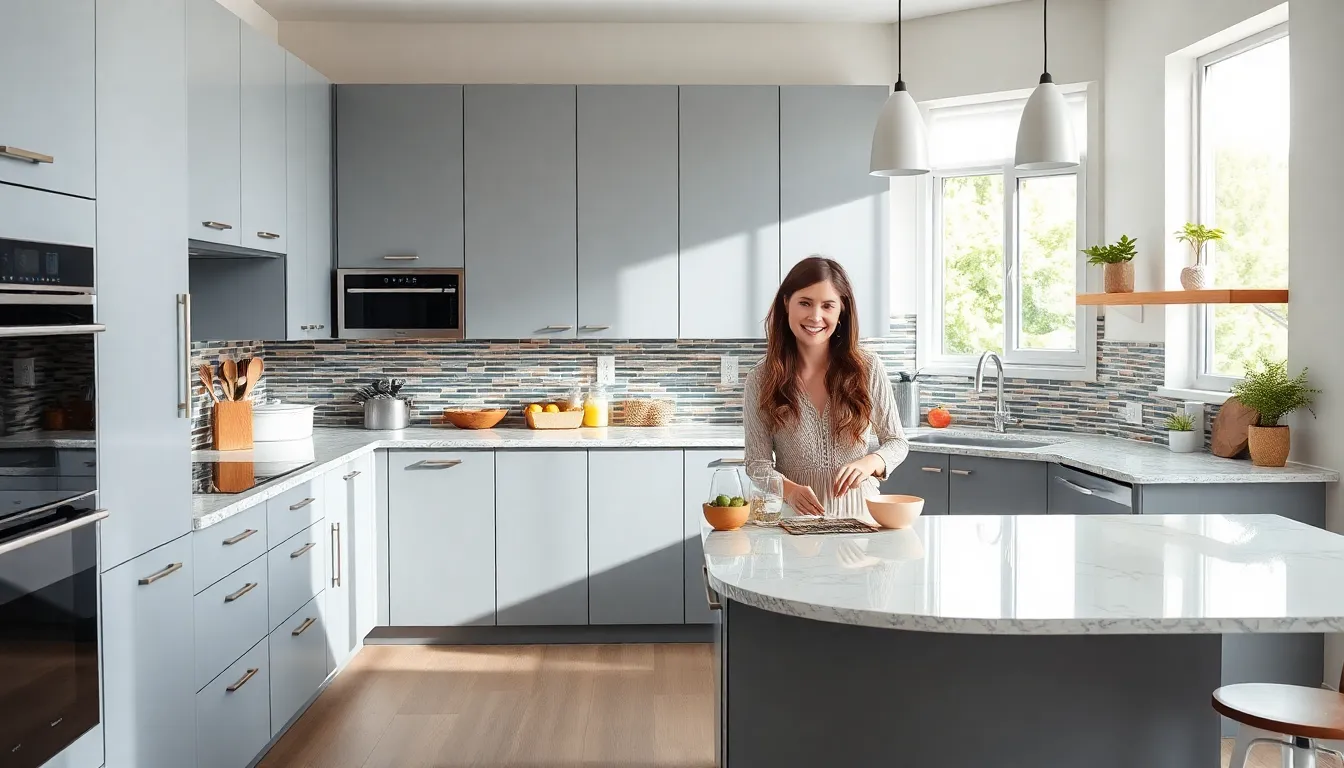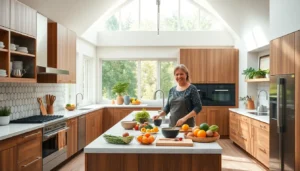A kitchen renovation can breathe new life into a home, transforming it into a vibrant space for cooking and gathering. With the right tips and strategies, homeowners can navigate the renovation process with confidence, ensuring a beautiful and functional kitchen that meets their needs.
From selecting the perfect layout to choosing durable materials, every decision plays a crucial role in the overall success of the project. Understanding the latest trends and timeless styles can help homeowners create a kitchen that not only looks stunning but also stands the test of time.
Whether it’s a complete overhaul or a simple refresh, these kitchen renovation tips will guide anyone looking to elevate their culinary space. With a bit of planning and creativity, achieving the kitchen of their dreams is closer than they think.
Table of Contents
ToggleEssential Kitchen Renovation Tips
Renovating a kitchen requires careful consideration of various factors. By following these tips, homeowners can execute an effective and satisfying renovation.
Assess Your Needs and Goals
Identifying specific needs and goals is crucial for a successful renovation. Homeowners should list essential features like storage solutions, upgraded appliances, and improved layout options. Considering lifestyle factors enhances functionality; families might prioritize space for interaction, while individuals may favor efficiency in cooking.
Set a Realistic Budget
Establishing a realistic budget sets the foundation for the renovation. Homeowners should research costs for materials, labor, and unexpected expenses, allocating 10-20% of the overall budget for contingencies. Prioritizing essential upgrades can prevent overspending, ensuring that high-quality finishes and appliances fit within financial limits.
Design and Layout Considerations

Design and layout significantly impact the functionality and aesthetics of a kitchen. Thoughtful planning ensures an efficient workflow and a harmonious appearance.
Choosing the Right Kitchen Layout
Choosing an effective kitchen layout enhances movement and improves usability. Popular layouts include:
- U-shaped: Provides ample counter space and storage, ideal for larger kitchens.
- L-shaped: Offers flexibility and accommodates dining areas or islands in smaller spaces.
- Galley: Maximizes efficiency in narrow kitchens, promoting a streamlined workflow.
- Island: Serves as a central hub for cooking and socializing, suitable for open-concept designs.
Homeowners should consider the “work triangle” concept, which suggests positioning the sink, stove, and refrigerator in a triangular arrangement to optimize workflow. Assessing the kitchen’s size and shape, as well as individual cooking habits, helps select the most suitable layout.
Selecting Colors and Materials
Selecting colors and materials creates a cohesive look and enhances durability. Consider the following options:
- Cabinet Colors: White and soft grays promote a bright, airy feel. Darker hues add elegance and depth.
- Countertops: Materials like quartz and granite offer durability while providing various aesthetics. laminate serves as a budget-friendly alternative.
- Backsplash: Glass or ceramic tiles can add texture and personality, making them a focal point without overwhelming the space.
Durability and maintenance are essential when choosing materials. Homeowners should prioritize easy-to-clean surfaces that withstand daily use while aligning with their desired style.
Functional Upgrades
Functional upgrades significantly improve the efficiency and usability of a kitchen. Focusing on storage solutions and energy-efficient appliances can elevate the overall kitchen experience.
Enhancing Storage Solutions
Enhancing storage solutions maximizes functionality. Homeowners can implement customized cabinetry, such as pull-out shelves and built-in organizers, to utilize every inch of space effectively. Deep drawers provide easy access to pots and pans, while vertical dividers neatly store baking sheets and cutting boards. Consider adding overhead shelving for frequently used items and maximizing corner cabinet space with lazy Susans or pull-out trays.
Additionally, incorporating multifunctional furnishings like kitchen islands with built-in storage can serve as both a cooking and gathering area. By selecting materials and finishes that complement the kitchen’s design, homeowners can maintain an aesthetically pleasing look.
Investing in Energy-Efficient Appliances
Investing in energy-efficient appliances results in long-term savings and environmental benefits. Homeowners should look for appliances with the ENERGY STAR label, which indicates compliance with strict energy efficiency guidelines. For example, ENERGY STAR-rated refrigerators, dishwashers, and ovens consume substantially less energy than standard models, which reduces utility bills while minimizing their carbon footprint.
Incorporating smart appliances adds convenience through connectivity and real-time performance monitoring. Smart refrigerators can track inventory and notify homeowners when supplies run low, while smart ovens allow for remote operation and cooking timing adjustments. By choosing energy-efficient and smart appliances, homeowners not only enhance their kitchen’s functionality but also contribute to a sustainable lifestyle.
Final Touches
Final touches elevate a kitchen renovation, enhancing functionality and aesthetics. It’s crucial to consider lighting, decor, and accessories for a polished and cohesive look.
Lighting Options for Your Space
Lighting profoundly influences the overall ambiance and functionality of a kitchen. Layered lighting combines ambient, task, and accent lighting, ensuring practicality and comfort.
- Ambient Lighting: Soft illumination from overhead fixtures, such as chandeliers or recessed lights, provides general lighting and sets the mood.
- Task Lighting: Focused lighting for work areas, including under-cabinet lights and pendant fixtures over islands, makes cooking and food prep easier and safer.
- Accent Lighting: Highlights design elements, like backsplashes or open shelving, using LED strips or spotlighting.
Consider dimmer switches to adjust brightness levels based on the time of day or activity, enhancing versatility and energy efficiency.
Decor and Accessories
Decor and accessories offer the final polish to a renovated kitchen, adding personality and style. Thoughtful choices create a welcoming atmosphere.
- Wall Art: Select functional and aesthetic pieces, like stylish clocks or framed prints, to personalize walls and enhance visual interest.
- Textiles: Use area rugs, window treatments, or decorative dish towels to introduce color and texture, adding warmth and comfort.
- Cabinet Hardware: Upgrade knobs and handles for a modern touch, ranging from sleek metal finishes to rustic wood options.
- Plants: Incorporate greenery with potted herbs or hanging plants, which improve air quality while adding life and color.
Strategically placing these elements can unify the kitchen’s design, ensuring it reflects the homeowner’s personality while remaining functional.
A kitchen renovation can truly redefine a home’s heart. By focusing on personal needs and preferences while incorporating functional upgrades, homeowners can create a space that’s both stylish and practical. Thoughtful planning around layout, materials, and lighting ensures that the kitchen not only looks great but also works efficiently for everyday use.
Investing time in research and setting a realistic budget will ultimately lead to a successful renovation. With the right choices in design and decor, the kitchen can become a welcoming environment for family and friends. Embracing creativity and functionality will result in a space that reflects individual style while enhancing the overall home experience.





